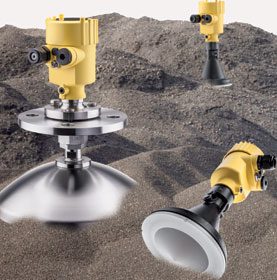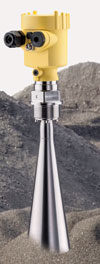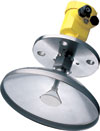

Almost nine years after introducing Vegapuls 68, its first radar sensor for bulk solids, 2013 saw Vega deliver sensor number 100 000.
“This production milestone carries forward the success story of radar level sensors in process automation. Today, they are the all-round level transmitter for liquids and bulk solids,” comments Günter Kech, managing director of Vega Germany. “Radar technology is on a success trajectory and we will ensure that it stays there by simplifying the level measurement of bulk solids with radar in the future.”
Number 100 000 bulk solids radar instrument is a Vegapuls SR 68. This landmark sensor went to Bühler in Switzerland, where the Swiss technology group is using it for level measurement in a 25 metre high cement silo.
Radar for solids

Vega launched Vegapuls 68, its first radar sensor specifically tailored to applications in the bulk solids industry, in 2004. Compared to radar sensors for liquids, the bulk solids radar sensor is capable of detecting and measuring signals 1000 times smaller – signals that were previously masked by ‘noise’.
These handy two-wire sensors have since become ‘the’ alternative to maintenance intensive, mechanical plumb bob systems, or ultrasonic sensors, which require an absolutely clear view to the product. Thanks to simple application parameters, only a few settings are necessary to fine-tune the radar sensor to the respective measuring task. The result is a measurement completely independent of dust, filling noise, strong air currents and high temperatures.
Versatile and robust
Three sensor variants ensure the advantages of radar technology for all kinds of applications, as well as measuring and temperature ranges. Vegapuls 68 is optimised for measuring ranges up to 75 m and temperatures up to 400°C, while Vegapuls SR 68 and Vegapuls 67 are designed for standard applications.
One basic technology thus covers a wide application spectrum – from level measurement in clinker coolers at 1500°C or in grain elevators, to level monitoring in rock crushers for mineral ore extraction.
Successful applications in a magnesia plant

One example of a successful application of the Vegapuls 68 is in a magnesia plant in Europe. This plant is the leading supplier of high-purity dead burned magnesia (DBM) in the region. The especially pure magnesium chloride deposits are salt formations that are quite unique in the world and they lie underground at a depth of about 1500 metres. The production of magnesia is a dusty affair, with about half a million tons of the material being extracted every year.
The sintered magnesia is processed at temperatures around 2200°C and applications of this refractory raw material range from cement and steel production to furnace linings, to production of non-ferrous metal, steel stabilisers and glass.
The paste-like base material is extracted from the mine and passed to the production unit where it is mixed with dolomite. In the ensuing reaction, magnesium hydroxide is precipitated. This is then dried in a furnace at 900°C. The resulting powder is transported by a conveyor belt to two storage containers 6 m high and 4 m in diameter. These are made of stainless steel, which is actually hard to see due to the thick layer of original material on the containers. But this is intentional. The top of the container has a temperature of over 100°C yet is safe to access for service thanks to the thick, heat-resistant material layer.
Any disruption of the ongoing production (the magnesium oxide burning process) costs the company a significant loss of revenue. But, these intermediate storage containers play an important role in preventing the furnace from being shut down for lack of storage space. They serve as a buffer for continuous, efficient operation of the kiln and indeed the whole production facility. Level information is thus an essential requirement for automating the magnesium oxide burning process.
The measuring task here is challenging. The bulk mineral has a low density, raises a good deal of dust and flows almost like a liquid. And that is not all; the material is also highly abrasive and has a residual temperature up to 700°C after the firing process. This is where the high-temperature Vegapuls 68 radar sensor is used with great success.
Despite heat, dust and strong abrasion, the sensor installed on the storage container has been delivering reliable measurement data for six years and continues to ensure smooth operation of the plant. Those responsible for the plant were surprised that Vega could solve this challenging measuring task with a standard instrument.
| Tel: | +27 11 795 3249 |
| Email: | [email protected] |
| www: | www.vega.com/en/home_za |
| Articles: | More information and articles about VEGA Controls SA |

© Technews Publishing (Pty) Ltd | All Rights Reserved